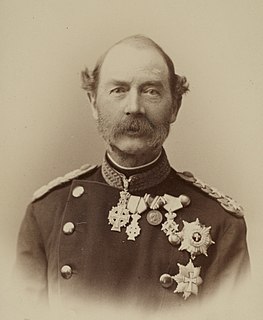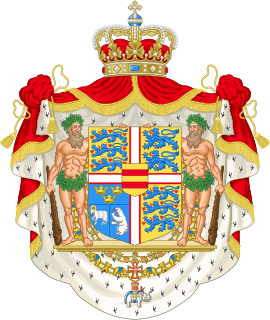| |||||
| Decades: | |||||
|---|---|---|---|---|---|
| See also: | Other events of 1762 List of years in Denmark | ||||
Events from the year 1762 in Denmark .
| |||||
| Decades: | |||||
|---|---|---|---|---|---|
| See also: | Other events of 1762 List of years in Denmark | ||||
Events from the year 1762 in Denmark .
| | This section is empty. You can help by adding to it. (July 2011) |
Frederick II was King of Denmark and Norway and Duke of Schleswig and Holstein from 1559 until his death.

Christian IX was King of Denmark from 1863 until his death in 1906. From 1863 to 1864, he was concurrently Duke of Schleswig, Holstein and Lauenburg.

Christian VIII was the King of Denmark from 1839 to 1848 and, as Christian Frederick, King of Norway in 1814.

Frederick III was king of Denmark and Norway from 1648 until his death in 1670. He also governed under the name Frederick II as diocesan administrator of the Prince-Bishopric of Verden, and the Prince-Archbishopric of Bremen (1635–45).

Frederick IX was King of Denmark from 1947 to 1972. Born into the House of Glücksburg, Frederick was the elder son of King Christian X and Queen Alexandrine of Denmark. He became crown prince when his father succeeded as king in 1912. As a young man, he was educated at the Royal Danish Naval Academy. In 1935, he was married to Princess Ingrid of Sweden and they had three daughters, Margrethe, Benedikte and Anne-Marie. During Nazi Germany's occupation of Denmark, Frederick acted as regent on behalf of his father from 1942 until 1943.Frederick became king on his father's death in early 1947. During Frederick IX's reign Danish society changed rapidly, the welfare state was expanded and, as a consequence of the booming economy of the 1960s, women entered the labour market. The modernization brought new demands on the monarchy and Frederick's role as a constitutional monarch. Frederick IX died in 1972, and was succeeded by his eldest daughter, Queen Margrethe II.

Frederick VII was King of Denmark from 1848 to 1863. He was the last Danish monarch of the older Royal branch of the House of Oldenburg and the last king of Denmark to rule as an absolute monarch. During his reign, he signed a constitution that established a Danish parliament and made the country a constitutional monarchy. Frederick's motto was Folkets Kærlighed, min Styrke .

Frederick I was the king of Denmark and Norway. His name is also spelled Frederik in Danish and Norwegian, Friedrich in German and Fredrik in Swedish. He was the last Roman Catholic monarch to reign over Denmark and Norway, when subsequent monarchs embraced Lutheranism after the Protestant Reformation. As king of Norway, Frederick is most remarkable in never having visited the country and was never crowned as such. Therefore, he was styled King of Denmark, the Vends and the Goths, elected King of Norway. Frederick's reign began the enduring tradition of calling kings of Denmark alternatively by the names Christian and Frederik, which has continued up to the reign of the current monarch, Margrethe II.

Frederick VI was King of Denmark from 13 March 1808 to 3 December 1839 and King of Norway from 13 March 1808 to 7 February 1814, making him the last king of Denmark–Norway. From 1784 until his accession, he served as regent during his father's mental illness and was referred to as the "Crown Prince Regent". For his motto he chose God and the just cause and since the time of his reign, succeeding Danish monarchs have also chosen mottos in the Danish language rather than the formerly customary Latin. As Frederick VI had no surviving sons to succeed him, he was succeeded on the throne of Denmark by his half-first cousin Christian, who was his father's half-brother's son.

Frederick IV was King of Denmark and Norway from 1699 until his death. Frederick was the son of Christian V of Denmark-Norway and his wife Charlotte Amalie of Hesse-Kassel.

Frederick V was king of Denmark–Norway and Duke of Schleswig-Holstein from 6 August 1746 until his death in 1766. He was the son of Christian VI of Denmark and Sophie Magdalene of Brandenburg-Kulmbach.

The House of Glücksburg, shortened from House of Schleswig-Holstein-Sonderburg-Glücksburg, is a collateral branch of the German House of Oldenburg, members of which have reigned at various times in Denmark, Norway, Sweden, Greece, and several northern German states.

The monarchy of Denmark is a constitutional institution and a historic office of the Kingdom of Denmark. The Kingdom includes Denmark proper, as well as the autonomous territories of the Faroe Islands and Greenland. The Kingdom of Denmark was already consolidated in the 8th century, whose rulers are consistently referred to in Frankish sources as "kings". Under the rule of King Gudfred in 804 the Kingdom may have included all the major provinces of medieval Denmark.
Events from the year 1723 in Denmark.
Events from the year 1730 in Denmark.
Events from the year 1746 in Denmark.
Events from the year 1753 in Denmark.
Events from the year 1754 in Denmark.
Events from the year 1756 in Denmark.
Events from the year 1766 in Denmark.
Events from the year 1670 in Denmark.
| Wikimedia Commons has media related to 1762 in Denmark . |